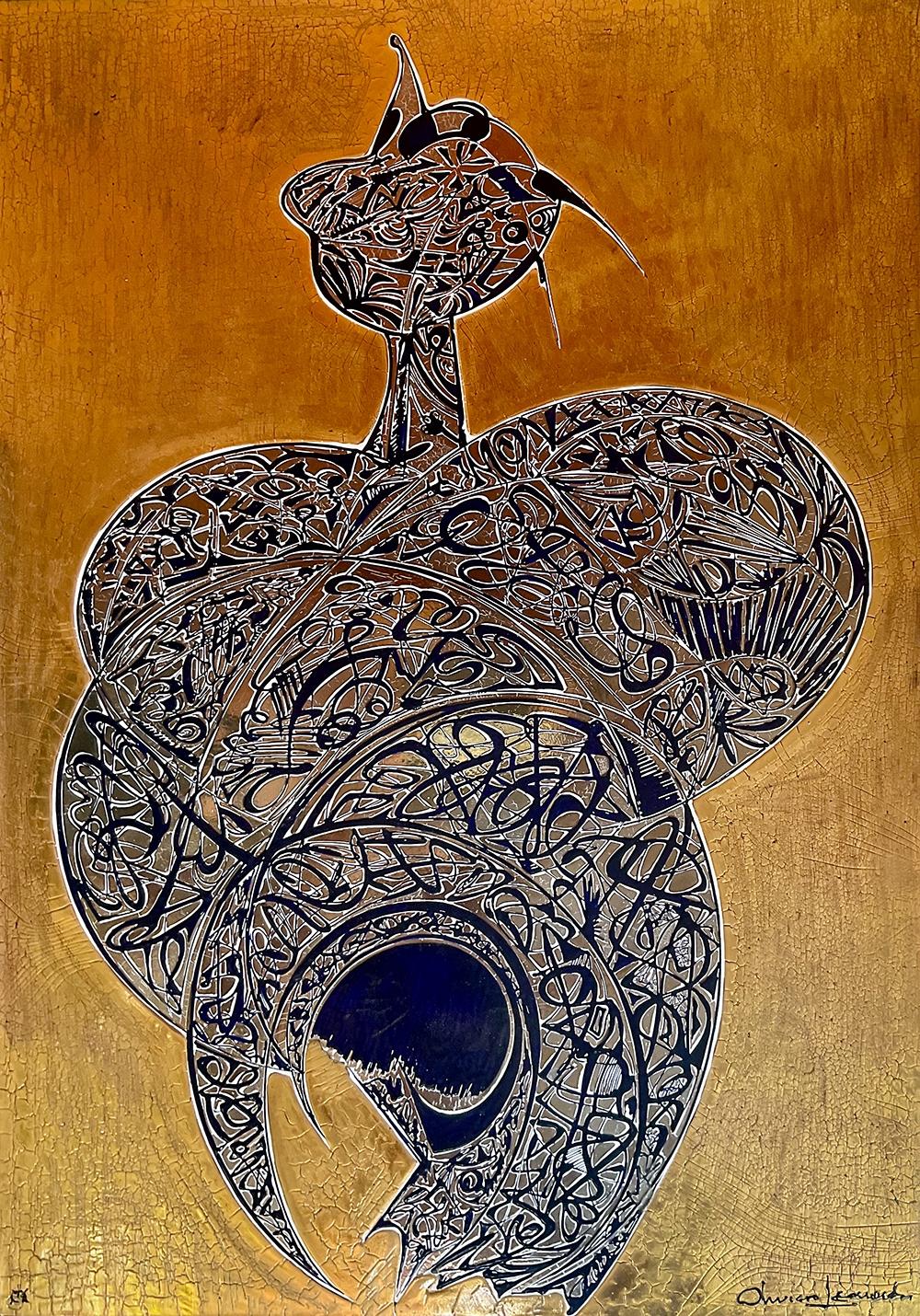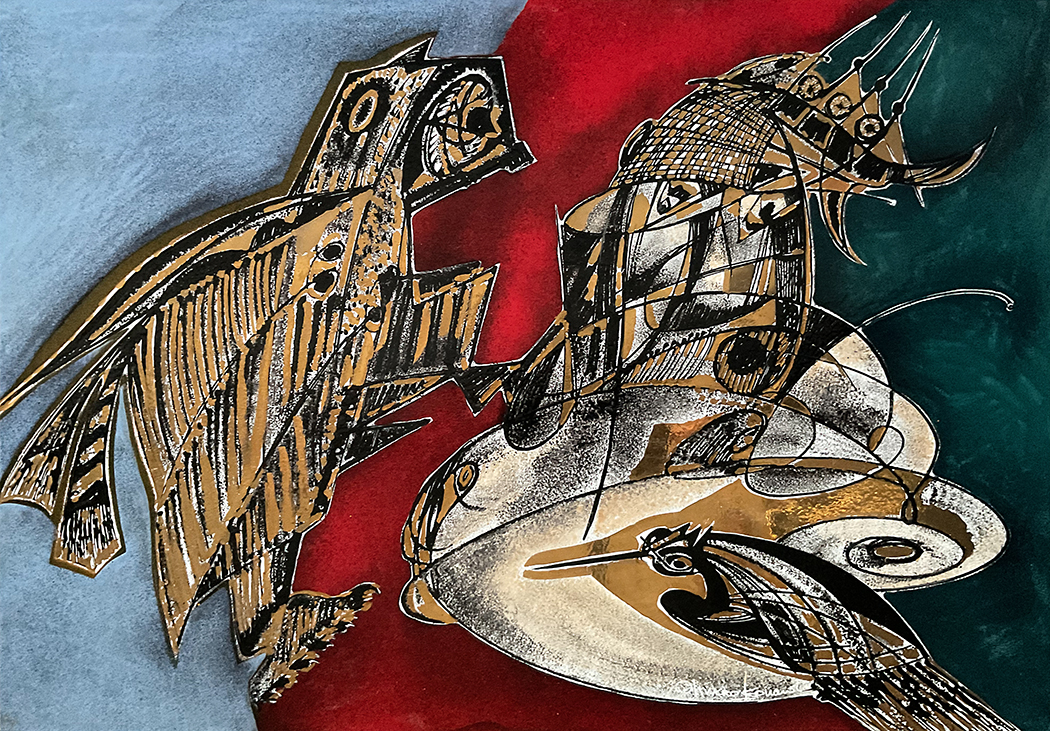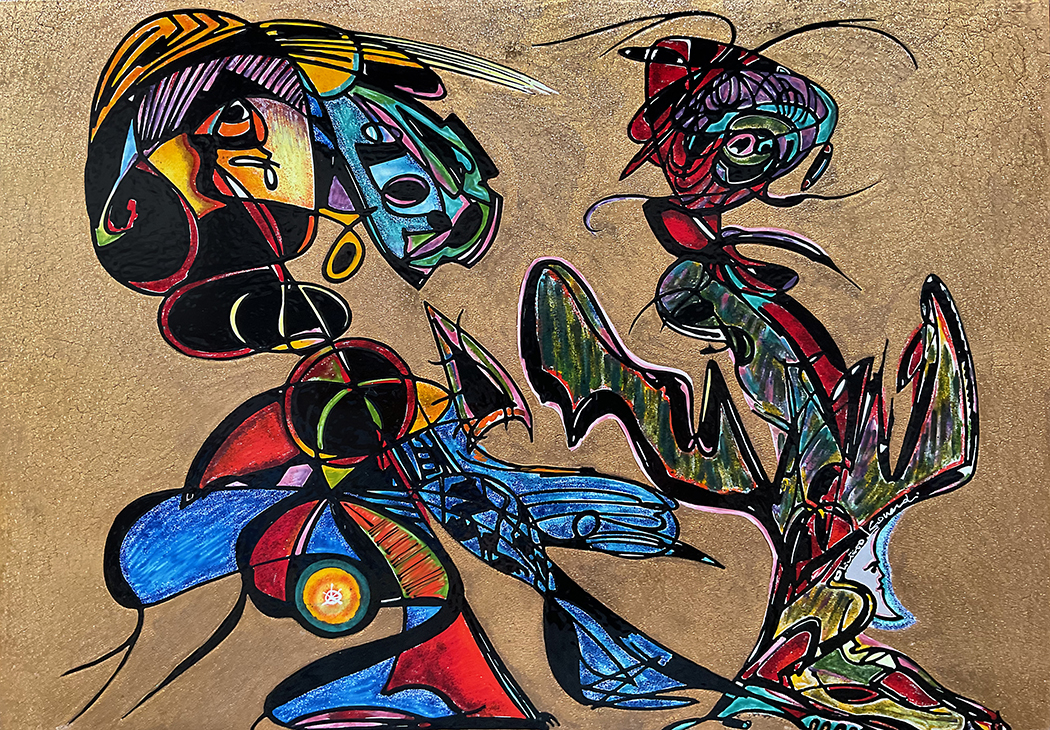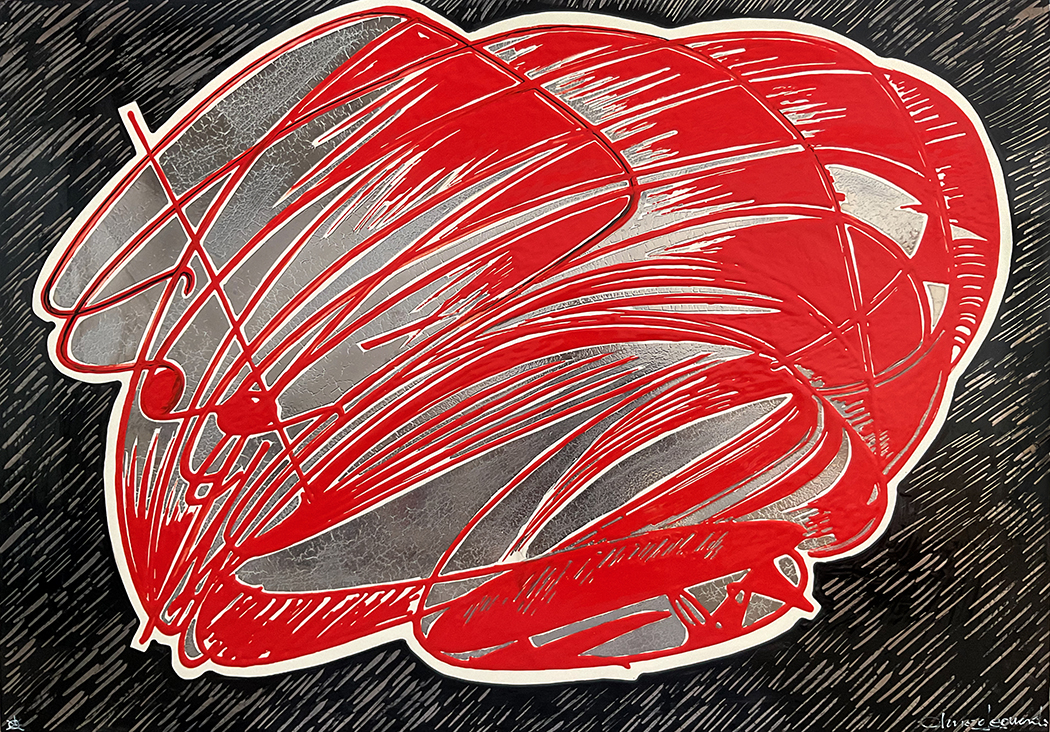Oliviero Leonardi
Oliviero Leonardi (1921 – 2019) was an Italian painter and sculptor based in Rome. He founded the Romacrea art school. He was using an innovative form of vitreous enamel painting as artistic medium, with his own mixtures of oxides and materials for enamel.
Can you tell us about Oliviero Leonardi’s early life and how his family’s background in ceramics influenced his artistic journey?
We believe that early contact with art made with/from fire must have been of great value for him as an artist. The best of his work is made similarly; his unique technique of art making, although based on enamel-metalwork, is looking at ceramic-making. He even calls his enamel paintings on steel plates ‘Ceramica’; ceramic, here, is not just the material, but the process, the final look, and memories brought into the work. It is stated in multiple art critics from the archives that Oliviero Leonardi ‘spent his youth’ next to his father and his kiln.
 Oliviero Leonardi | The Devil Visits The Dove Woman | Copyright Association Oliviero Leonardi
Oliviero Leonardi | The Devil Visits The Dove Woman | Copyright Association Oliviero Leonardi
What inspired Leonardi to experiment with steel plates and high-temperature firing techniques in his artwork?
Not many artists in the 20th century were working with this technique, so there are, probably, no direct influences. His family background, as his ancestors were famous ceramicists from Trento, Italy, was an early example of art-making with fire – the process of ‘baking as making (art)’ was not new to him. The second inspiration could be his friendship with Italian avant-garde artist and futurist, Fortunato Depero. His innovative, dynamic, historical approach to art, with an obsession for future – and futuristic techniques, were probably very important to Leonardi’s artistic formation. Third, after the war, Leonardi spent many years on the island of Capri experimenting with different materials and traveled to multiple Italian cities famous for their artistic tradition. Those travels after the war may have opened to him a world of experimentation and artistic innovation.
Could you explain the process Leonardi used to create his unique artworks using high-temperature firing techniques?
The process is an innovative form of vitreous enamel, so called ‘porcelain’ or ‘ceramic’ enamel.Enamel is an ancient art technique, it is the process of fusing silica-based (glass), colored (oxides) mixtures with metal, under a fire of 700-850 degrees Celsius. Other artists have used precious metals in the past – some interesting examples of this technique are Faberge eggs. But Leonardi used steel, which was innovative for that time (enamel on steel was typically used in industry);he also used his own mixtures of oxides and materials for enamel, such as volcanic ash; and, because he used steel and experimented with materials/mixtures, he had to use special ovens to fire his paintings at 900 degrees Celsius, for artmaking ‘at great fire’, as he called the process. He was innovative in many ways, one of the leaders in that field in the 70s and 80s, whose art and the process of art-making are considered an innovation even today. For more details on Leonardi’s technique, you may visit this webpage: https://oliviero-leonardi.com/technique/
 Oliviero Leonardi | Odyssey Of The Universe | Copyright Association Oliviero Leonardi
Oliviero Leonardi | Odyssey Of The Universe | Copyright Association Oliviero Leonardi
What challenges did Leonardi face when working with steel plates, and how did he overcome them?
First of all, steel plates were not the typical medium in the world of art (not even today), especially not as a painting support. It was kind of a controversial usage, it was the real avant-garde moment, but at the same time, something of a side-art, something between the painting and the applied art, and none of them. That is not an easy position for an artist. Even in the text for the catalog of Limoges Biennale for enamel art in 1986 (where he also presented his works), this dilemma is presented: is enamel ready to compete with oil painting? On the other hand, working with metal is not an easy task, timing and proper handling are everything.
 Oliviero Leonardi | Irony Of An Encounter | Copyright Association Oliviero Leonardi
Oliviero Leonardi | Irony Of An Encounter | Copyright Association Oliviero Leonardi
How did movements like futurism, surrealism, cubism, and art Informel impact Leonardi’s artistic style?
Futurism impacted him directly, not only because he was a good friend to Depero, the famous ‘original’ futurist, but because his roots are in Italy, and every Italian artist in the 20th century saw two options, at least at the beginning of his career: Tradition or Futurism. Leonardi fused both, but his initial phase wasmore futurist-oriented; imagined future and dynamic space around us is his constant preoccupation. Besides that, the influence of surrealist motifs and themes – those of dreams, of primordial, of egg-like, fetus-like forms, is obvious. Cubist art did not have that much impact on him – but he made homages to Picasso in many of his works, directly or indirectly. His drawing is, where the line is important, very similar to the line of Picasso. Art Informel was something that was happening around him. His surroundings, his living in a contemporary world. Another source for rethinking art medium, visuality, tradition. The ‘light’ after the war.
What were some of the highlights of Leonardi’s career during the 1970s and 1980s?
At the peak of his career, back in the 70s and 80s, he was recognized as an important actor of, at that time, Italian contemporary art; his works were studied by such important art historians and critics like Carlo Giulio Argan or Elio Mercuri, and many international experts on Modern or Early Modern art, like Gustav Rene Hocke. His art was known worldwide, as his works, artistically impressive and resilient in their nature, were commissioned for public spaces from Rome to New York and Brasilia. He also exhibited in such important galleries that introduced and made modern art visible, such as Galerie Drouant, or Van Gogh House. Not to mention the opening of his school of art, Romacrea (in Rome), or special prizes for the technique he used – all the inventions he introduced to the medium. There are several institutions that preserve archives on Oliviero Leonardi including Fondazione La Quadriennale di Roma.
Could you share some memorable experiences or stories from his exhibitions in various countries?
It looks like Leonardi had special bonds with curators, critics, and historians who admired his art. It is interesting to note that he was working closely with, for example, Argan or Hocke, both giving their best to introduce him to the world of art. Hocke even wrote a monograph about him, and each catalog he needed for every exhibition he had in Germany, or generally, outside Italy. We believe that it is thanks to Hocke that Leonardi was able to have a solo museum show in Germany at the Saarland Museum in 1979, as well as be included in the Oxford Benezit. Another memorable experience worth mentioning is his connection with the Rome artistic community and the multiple studio visits he organized for them. We can count at least 4 large studio visits with more than 50 persons attending. Leonardi was very fond of this as it enabled him to better share his creative process and artistic views directly in/from his art studio, which he called “Studio Casale”.
 Oliviero Leonardi | War In The Desert | Copyright Association Oliviero Leonardi
Oliviero Leonardi | War In The Desert | Copyright Association Oliviero Leonardi
What emotions or messages did Leonardi hope viewers would take away from his art?
He wanted his art to convey the message of eternal quality, life, and primordial energy – that grows stronger as time passes by. He was not interested in the fleeting nature of things, in banality, or superficial events. His art is very deep, and very personal, but speaks to anyone. It was imagined as some kind of universal language of visual signs that represents life as a whole; those signs that represents life as a whole; those signs are easy to understand, especially following the labels, but simple does not mean banal. That is the main point of his art: showing the complex and unknown world around us with primordial signs – in a sense that it is something inherently known to us. Something that we see, and, somehow, instantly recognize.
How do you feel about Leonardi’s work being almost forgotten for a period, and what efforts are being made to revive interest in his art?
It is something that just happens, sometimes without any obvious reason. In the case of Oliviero Leonardi, a chain of circumstances happened: from his decision resign from the world of art when he was still a famous and well-known artist, to the fact that his art belongs to that liminal space between fine arts and applied arts, considering the technique he used and invented, just to give one example. For us, after the historical distance, it looks like a pity that the work and life of such an innovative and dedicated artist is currently forgotten. Because his legacy is preserved in such good condition, we believe that there is no point in delaying working on a rediscover and recontextualization process, as we believe he still can mean something to us today, that he can inspire new artists, new critics, and art historians. In that sense, we plan to keep running the website dedicated to the artist (www.oliviero-leonardi.com),to continue collaborating with academics and curators, and be in touch art magazines and academic journals about his work. We have digitized a large number of archives, which we have made available publicly. We also plan to exhibit his work; he is currently scheduled for 2 biennials and 1 museum exhibition. We believe that the story of Leonardi is worth sharing and engaging with. We are open to interesting collaborations, particularly with art historians, art curators, artists, conservators, art experts, public and private institutions, and collections and collectors.
Looking back on Leonardi’s extensive career, what do you consider his most significant contribution to the art world?
His inventions and experiments. He is an innovative creator, both in terms of technique and artistic expression. Bringing the arts and crafts closer together. The philosophical, historical, and poetical in his work. The intuition.
 Oliviero Leonardi | Dynamic Abstract | Copyright Association Oliviero Leonardi
Oliviero Leonardi | Dynamic Abstract | Copyright Association Oliviero Leonardi

Leave a Reply